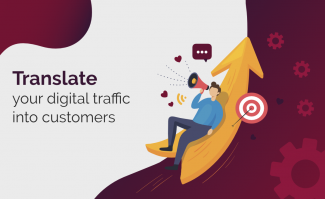
2020 has brought big surprises. Leverage booming digital traffic by driving customers to your products and services wherever they may be. But… English won’t be enough.
Translate to Go Global Faster
Over the past month, global internet traffic has experienced an explosion of growth - resulting in a cumulative increase of between 30%-50% and, in some cases, over 50% over ‘normal’ weekend peak traffic.[1] At the same time, many companies still find it difficult to be visible in the vast e-commerce environment. Why is that?
Although English is still the dominant language in e-commerce, many consumers want to buy goods and services in their own language. According to the My Europe. My Language. study, consumers are six times more likely to buy from e-commerce sites where the content is in their native language.[2] Translating your e-commerce sites will translate into higher customer engagement.
Translation powers your success in new markets by adapting your product or service to your target location. Translate the webpage and marketing materials into your customers’ language, and they will be more likely to not only engage with the content, but also spread the word about your brand, and you will create a positive brand image. But translation alone is not enough. In order to be visible to your target markets local search, SEO (search engine optimization) is the solution to this puzzle.
SEO is your key to internet visibility
Now is the time to be visible on the first page of Google Search results. In the digital age, SEO is a crucial component of being visible to your potential clients. The right SEO is more essential than ever. Remember to include SEO in your localization process to guarantee that your clients find you.
SEO is vital for your whole internet presence and sets you apart from your competitors. Make sure your SEO is consistent across all languages and channels: webpages, blog posts, product descriptions etc. There are two main approaches to a multilingual SEO. Translating your content and optimizing it afterwards, or firstly identifying the keywords that you will progressively incorporate during the localization process.
Be sure to convey the true meaning of your brand
Consistent keyword identification and localization in your content are key to giving you an advantage in the internet search puzzle. We recommend teaming up with a translation service provider that is experienced in creating and consistently using keywords across translations in multiple languages. Professional editors will create glossaries and terminology collections so that translators always use the same approved keywords. While working with high-value keywords data, it is essential to see content from a human perspective. A professional translator will be able to make a decision that's best not only from the perspective of the SEO but also from that of brand image, ensuring that the text’s true meaning is adapted in keeping with local language jokes or idioms.
Lessons learned and advice
For a company to improve its chances of being visible in e-commerce, it does not require a large financial investment or complicated processes. With a relatively low-cost, but smart strategy, a company can increase sales of products and services very rapidly. Remember, consumers prefer their mother tongue that's why translation and SEO are two indispensable elements of a successful e-commerce online presence.

Ieva Simane
Business Development Manager Connect via Linkedin or reach out via translations@tilde.com
Interested in learning how to set up your own SEO translation workflow? We’re here to help!
________________
[1] Nokia Deepfield, https://www.nokia.com/blog/network-traffic-insights-time-covid-19-march-16-march-22-update/
[2] My Europe. My language. With language technologies made in the EU – Brochure, 2019